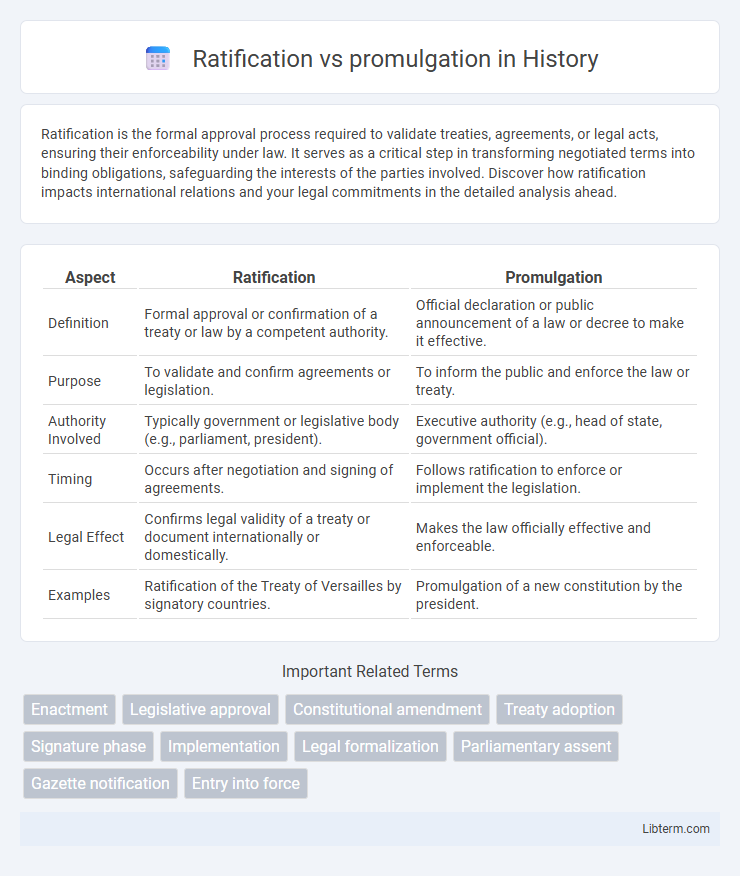Ratification is the formal approval process required to validate treaties, agreements, or legal acts, ensuring their enforceability under law. It serves as a critical step in transforming negotiated terms into binding obligations, safeguarding the interests of the parties involved. Discover how ratification impacts international relations and your legal commitments in the detailed analysis ahead.
Table of Comparison
| Aspect | Ratification | Promulgation |
|---|---|---|
| Definition | Formal approval or confirmation of a treaty or law by a competent authority. | Official declaration or public announcement of a law or decree to make it effective. |
| Purpose | To validate and confirm agreements or legislation. | To inform the public and enforce the law or treaty. |
| Authority Involved | Typically government or legislative body (e.g., parliament, president). | Executive authority (e.g., head of state, government official). |
| Timing | Occurs after negotiation and signing of agreements. | Follows ratification to enforce or implement the legislation. |
| Legal Effect | Confirms legal validity of a treaty or document internationally or domestically. | Makes the law officially effective and enforceable. |
| Examples | Ratification of the Treaty of Versailles by signatory countries. | Promulgation of a new constitution by the president. |
Introduction to Ratification and Promulgation
Ratification is the formal approval or confirmation of a treaty, agreement, or law by an authorized body, typically a legislative or governmental entity, validating the document's legal status. Promulgation refers to the official publication or declaration of a law or regulation, ensuring its accessibility and enforceability within a jurisdiction. Understanding the distinction between ratification, which emphasizes consent and legitimacy, and promulgation, which focuses on public notification, is essential in legal and administrative processes.
Defining Ratification
Ratification is the formal approval or confirmation of an act, agreement, or legal document by a competent authority after it has been signed or executed. It grants validity and legal effect to actions that were initially performed without full authority, ensuring their compliance with governing laws or regulations. In contrast, promulgation involves the official announcement or publication of a law or decree to make it enforceable and publicly known.
Understanding Promulgation
Promulgation refers to the formal process through which a law or regulation is officially declared and published, making it binding and enforceable. This process often involves the publication of the legal text in an official government gazette or registry, ensuring public awareness and compliance. Unlike ratification, which confirms an agreement or treaty, promulgation emphasizes the public dissemination and formal enactment of legislative or administrative acts.
Key Differences Between Ratification and Promulgation
Ratification is the formal approval of a decision or treaty, typically by a legislative body or authorized authority, confirming its validity after initial agreement. Promulgation involves the official public announcement or publication of a law or regulation, marking the moment it becomes enforceable. The key difference lies in ratification being a post-agreement consent process, while promulgation is the act of declaring the law effective and binding.
Legal Significance of Ratification
Ratification holds crucial legal significance as it validates and confirms actions or agreements initially made without full authority, transforming them into legally binding obligations. It ensures that treaties, contracts, or legislative acts receive official approval from the appropriate authority, typically a sovereign or legislative body, thereby legitimizing their enforcement. Unlike promulgation, which is the formal announcement or publication of a law or treaty, ratification solidifies the consent and commitment necessary for legal effect.
Importance of Promulgation in Law
Promulgation is crucial in law as it officially communicates legal statutes to the public, ensuring transparency and enforceability by providing the necessary legal notification. Without promulgation, laws lack formal public disclosure, which could result in unenforceability and legal uncertainty. Ratification validates an agreement or decision, but promulgation establishes its binding effect and operational status within the legal system.
Ratification Process Explained
Ratification is the official approval of a treaty or agreement by a country's authorized body, usually its legislature or head of state, confirming consent to be legally bound. The ratification process involves formal procedures such as signing the treaty, submitting it to the legislative body for review, and obtaining a majority vote or consent as required by national law. This process ensures the treaty's provisions become enforceable domestically, distinguishing it from promulgation, which is the formal proclamation or publication of the law or treaty after ratification.
Steps Involved in Promulgation
Promulgation involves formally announcing and enforcing a law after it has been ratified, typically requiring official publication in a government gazette or legal register to inform the public. The steps in promulgation include the approval of the legislative body, issuance of a formal decree by the executive authority, and publication to ensure legal enactment and public awareness. This process is crucial for the law's legal effect and operational implementation within the jurisdiction.
Real-world Examples of Ratification vs Promulgation
The United States Constitution was ratified by the states in 1788, illustrating ratification as formal approval required to validate a legal document, while its subsequent promulgation declared the Constitution as the supreme law. Another example includes international treaties like the Paris Agreement, which nations ratify through their legislative bodies, followed by promulgation through official government publication to enforce the treaty domestically. In corporate law, board resolutions are ratified by shareholder approval and then promulgated via corporate records and public disclosures.
Conclusion: Choosing Between Ratification and Promulgation
Choosing between ratification and promulgation hinges on the legal and procedural context, as ratification confirms and legitimizes pre-existing agreements or acts, while promulgation involves formally announcing or enacting laws or decisions. Ratification is essential when validating international treaties or agreements requiring approval from authoritative bodies, ensuring their enforceability. Promulgation is crucial for domestic legal systems to formally introduce and publicize statutes, ensuring citizens are informed of new laws.
Ratification Infographic

 libterm.com
libterm.com